Learning how to juggle is a fantastic way to enhance your coordination, focus your mind, and impress your friends. At LEARNS.EDU.VN, we believe everyone can learn this rewarding skill with the right guidance and practice. This comprehensive guide provides you with step-by-step instructions, expert tips, and valuable resources to master juggling. Whether you’re a complete beginner or looking to refine your technique, this article will empower you to achieve your juggling goals, improve your dexterity, and develop patience. Let’s embark on this exciting journey together, exploring the nuances of prop manipulation, rhythmic movement, and hand-eye coordination.
1. Understanding the Basics of Juggling
Before diving into the techniques, let’s explore the fundamental principles that make juggling possible. Mastering these concepts will lay a solid foundation for your juggling journey.
1.1. The Core Principles
Juggling isn’t just about throwing objects into the air; it’s about control, timing, and rhythm. Here are the key principles:
- Consistent Throws: Aim for consistent height and trajectory in each throw. This consistency creates a predictable pattern that’s easier to manage.
- Even Rhythm: Maintain a steady pace in your throws. This helps you coordinate your movements and prevents the pattern from becoming chaotic.
- Hand-Eye Coordination: Develop the ability to track the balls with your eyes and coordinate your hand movements accordingly.
- Relaxation: Stay relaxed! Tension can disrupt your rhythm and lead to mistakes.
1.2. Essential Equipment: Choosing the Right Juggling Balls
The right equipment can make a significant difference in your learning experience. Here’s what to consider when choosing juggling balls:
- Beanbags: These are ideal for beginners. They are soft, easy to catch, and won’t roll away when dropped. Look for beanbags that fit comfortably in your hand.
- Weight: The weight of the ball affects its stability in the air. Start with lighter balls (around 100-130 grams) and gradually increase the weight as you improve.
- Material: Leather or synthetic materials are durable and provide a good grip. Avoid slippery materials that can make catching difficult.
- Size: A ball size that fits comfortably in your palm is crucial. Typically, a diameter of 2.5 to 3 inches is suitable for most adults.
Table 1: Recommended Juggling Balls for Different Skill Levels
| Ball Type | Weight (grams) | Diameter (inches) | Material | Skill Level |
|---|---|---|---|---|
| Beanbags | 100-130 | 2.5-3 | Leather/Synthetic | Beginner |
| Stage Balls | 130-150 | 3-3.5 | Plastic/Rubber | Intermediate |
| Russian Balls | 110-140 | 2.75-3.25 | Various | Advanced |
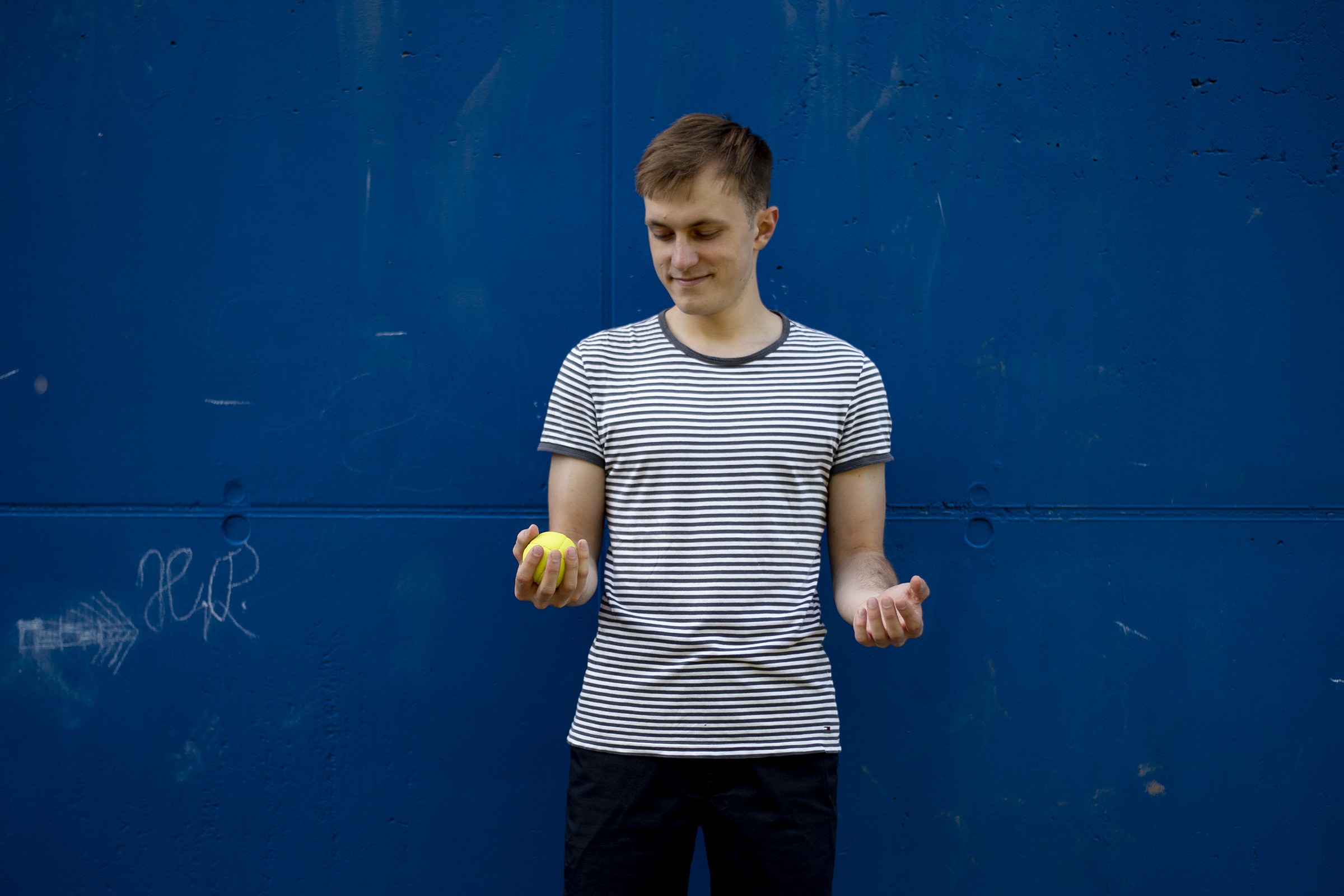




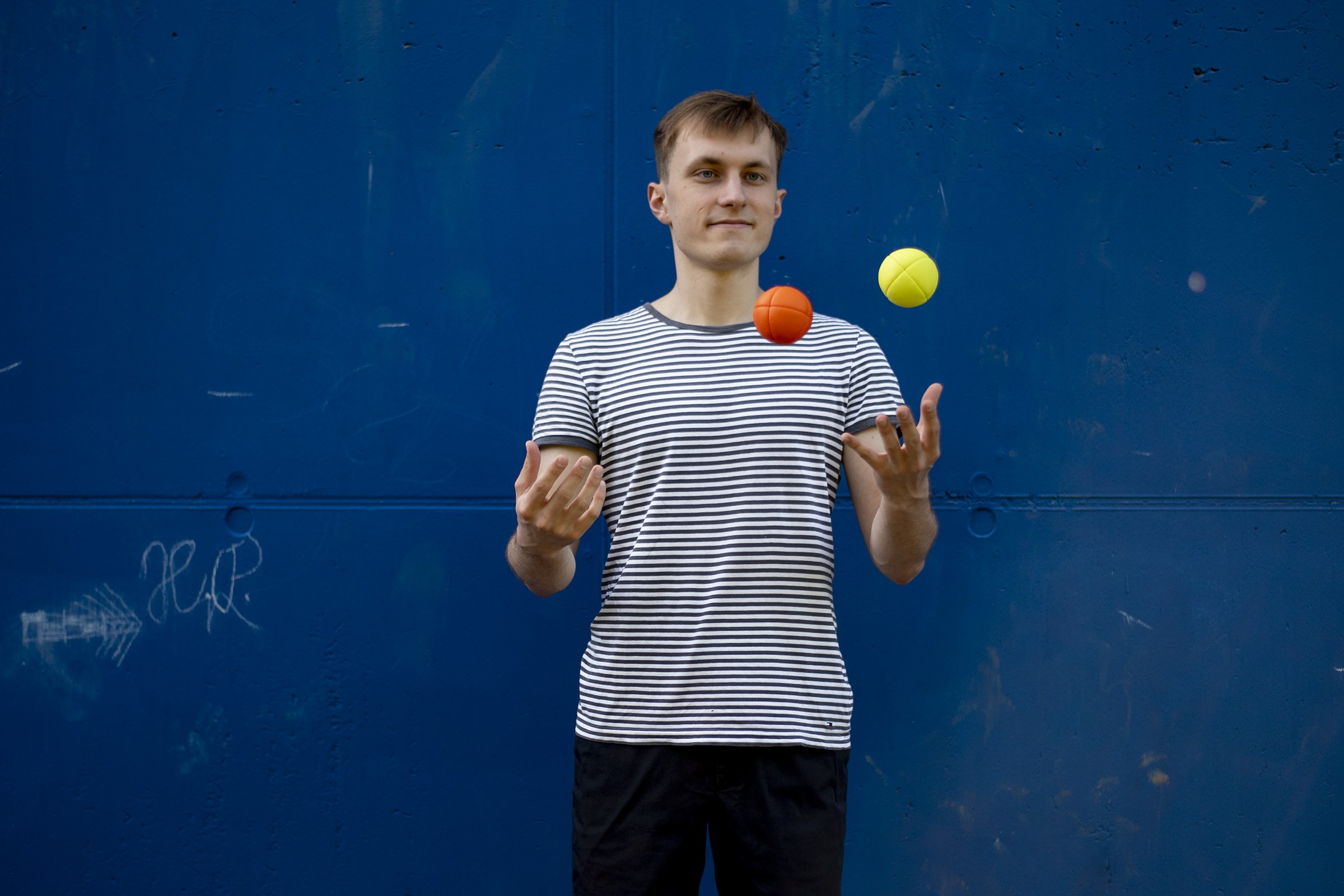
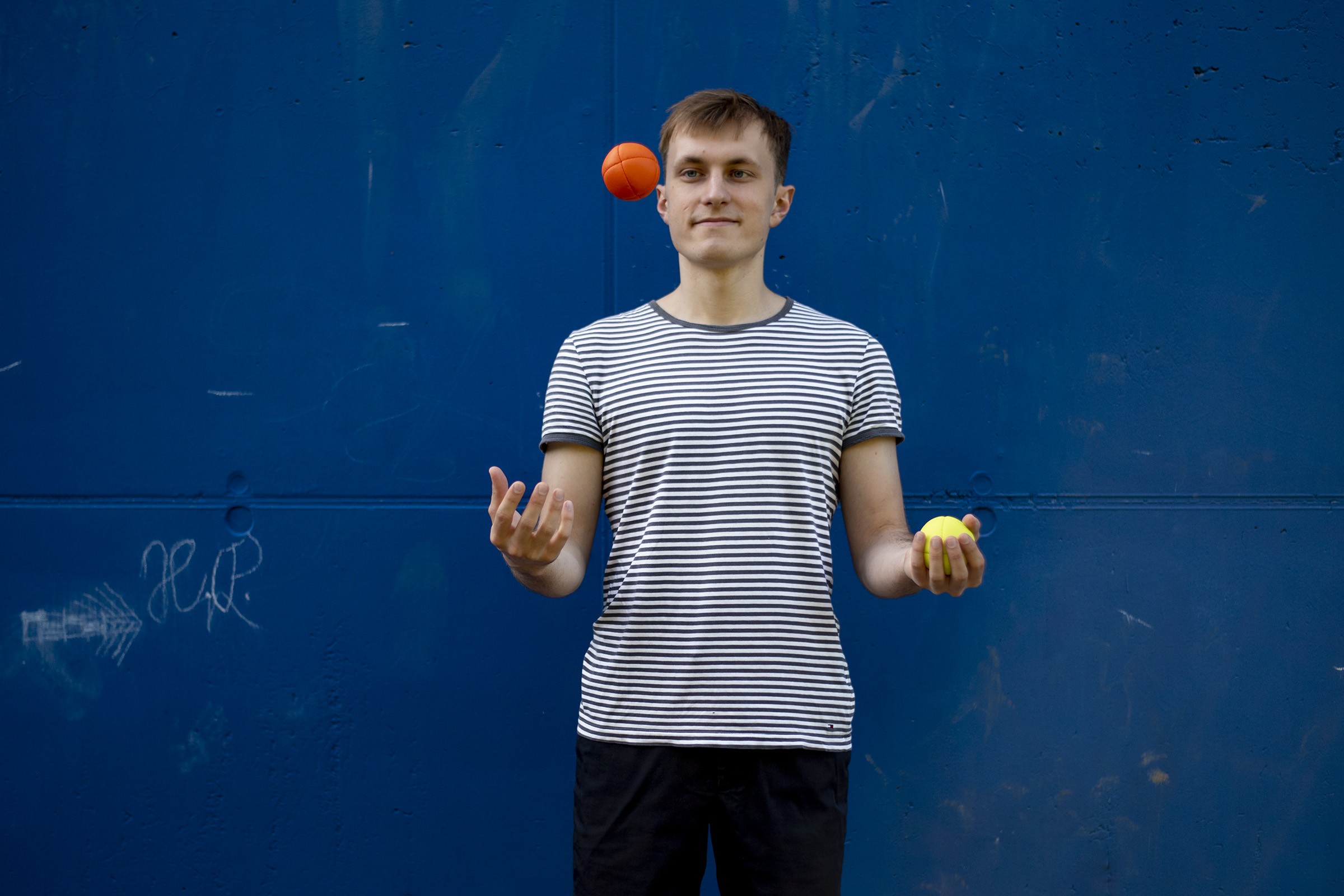

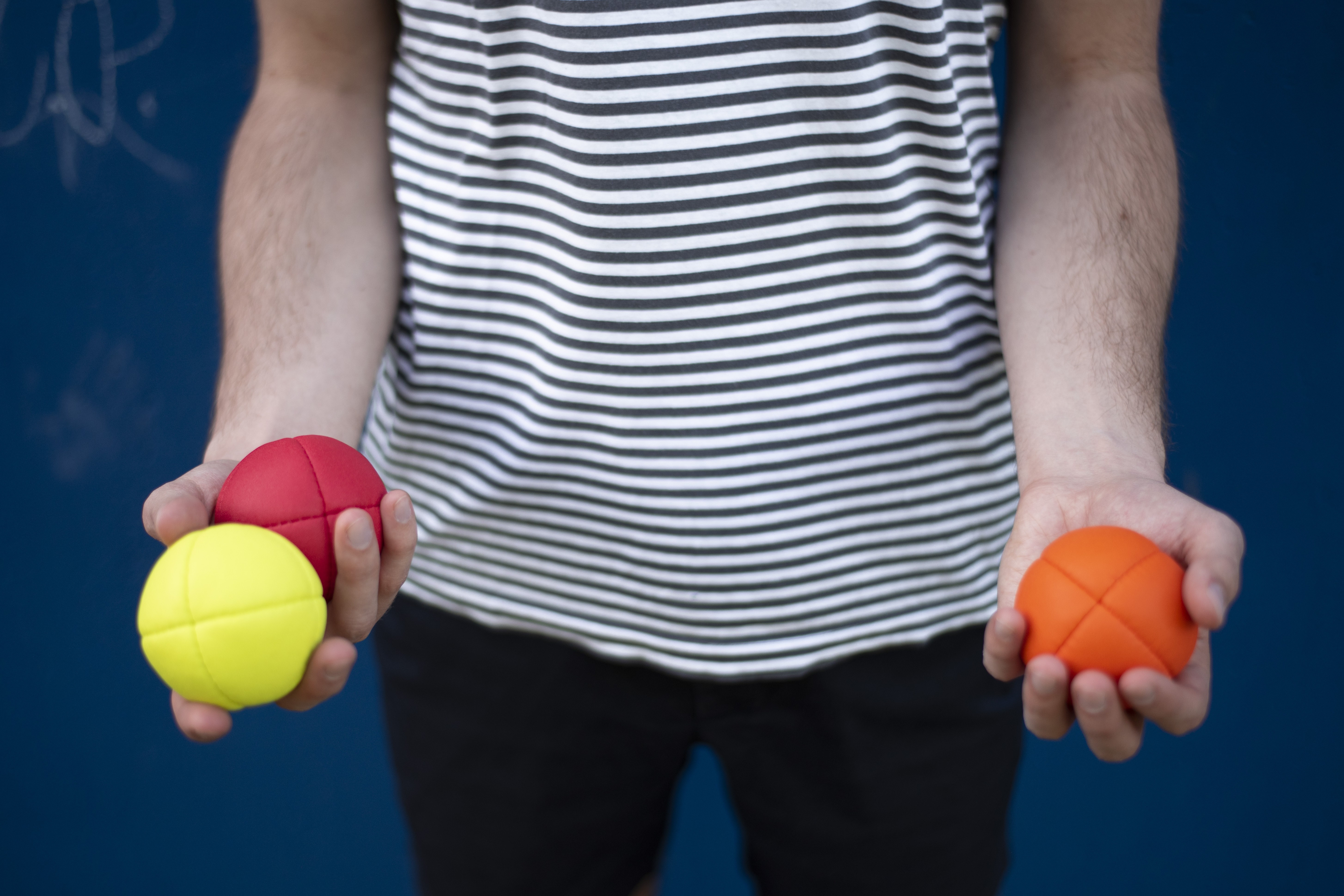



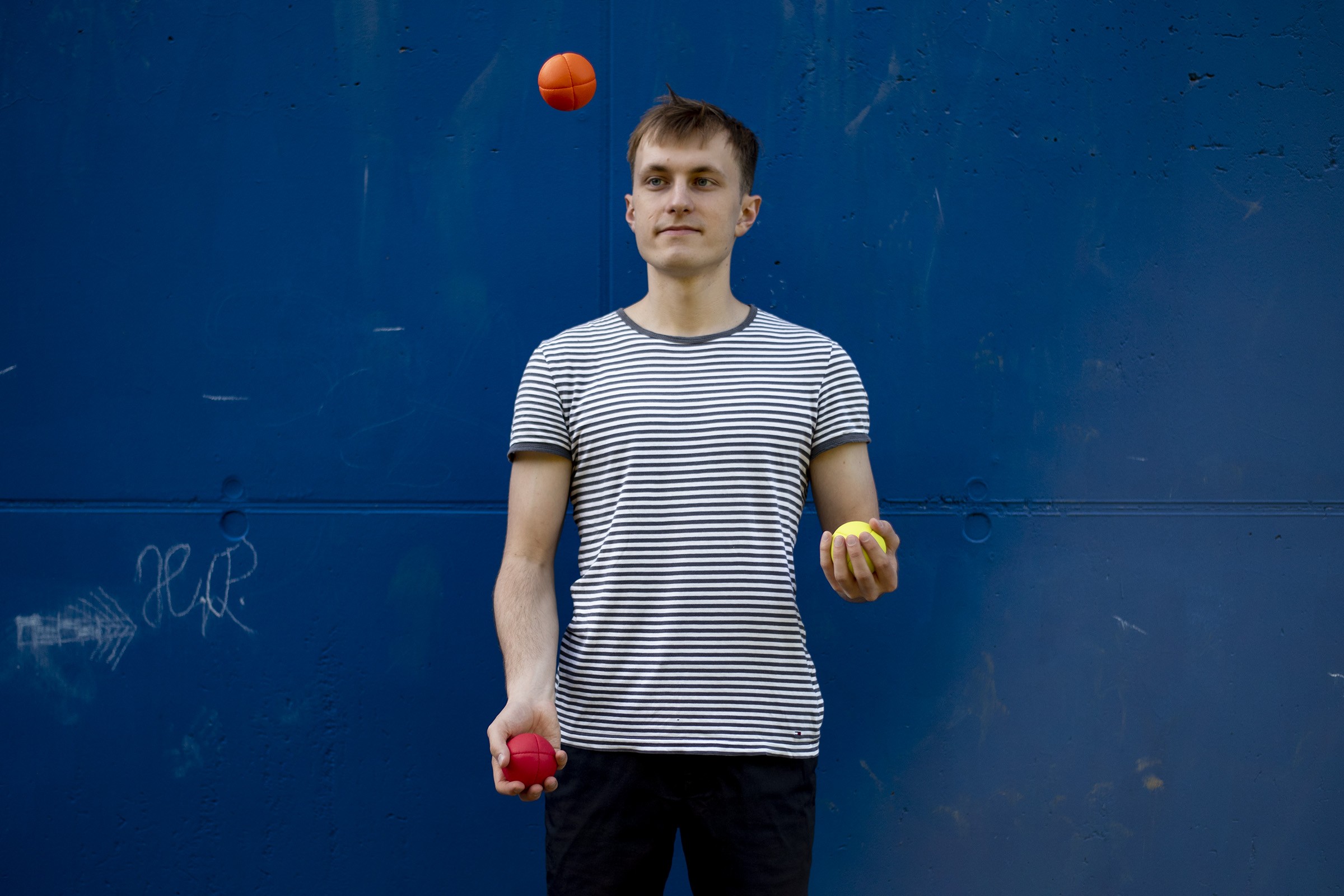

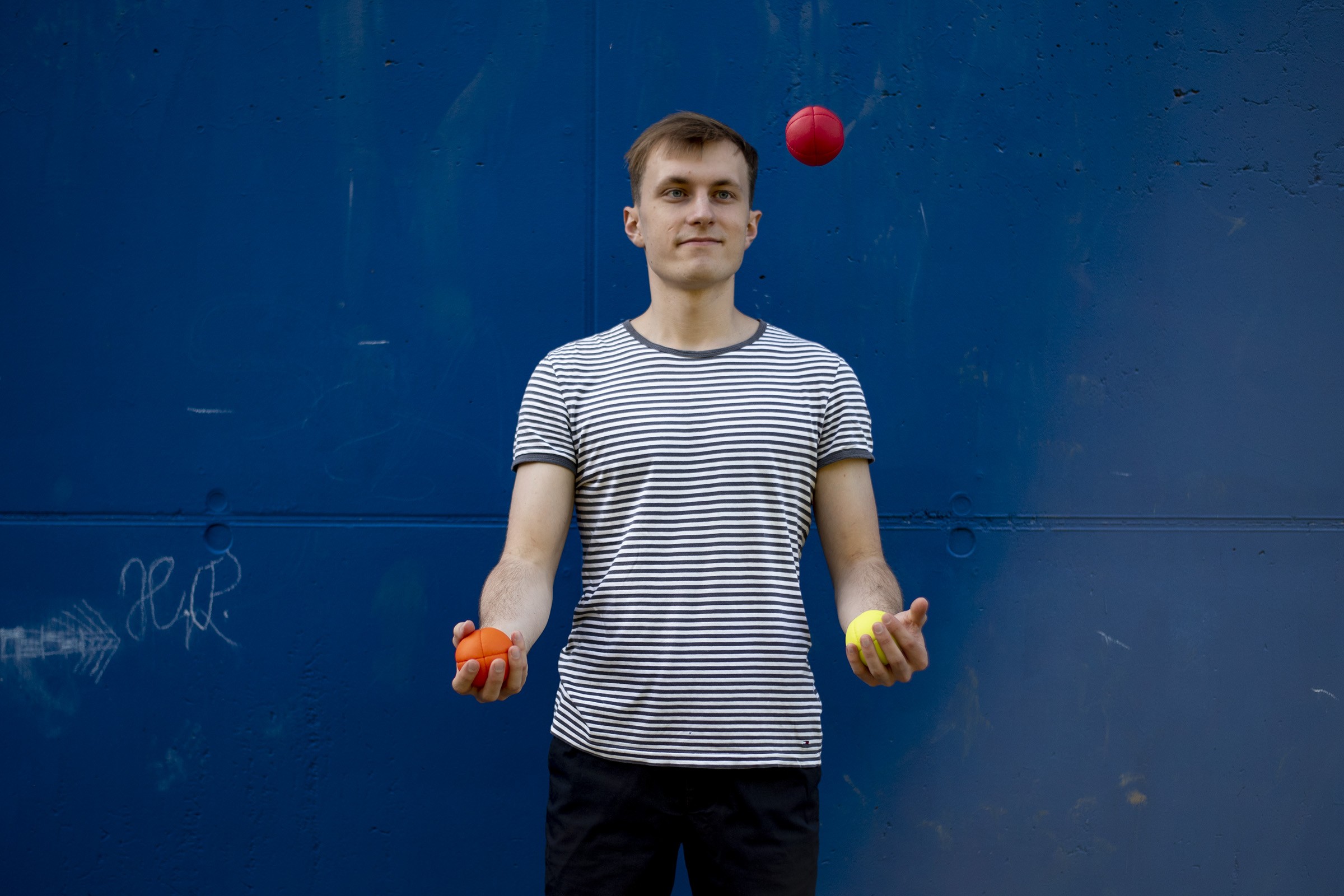
1.3. Setting Up Your Practice Space
Creating the right environment can help you focus and practice effectively.
- Indoor vs. Outdoor: Indoors is ideal for beginners as it eliminates weather distractions. However, outdoor practice is great for more advanced moves requiring space.
- Soft Surface: Practice over a carpet or grass to cushion drops and prevent balls from rolling away.
- Adequate Space: Ensure you have enough headroom and space to move around without obstacles.
- Minimal Distractions: Choose a quiet area where you can concentrate without interruptions.
2. Mastering the 3-Ball Cascade: A Step-by-Step Guide
The 3-ball cascade is the most fundamental juggling pattern. It involves throwing and catching three balls in a continuous, flowing motion. This section breaks down the cascade into manageable steps.
2.1. Step 1: The Single Ball Toss
Before juggling multiple balls, it’s essential to master the basic throwing motion.
- Starting Position: Hold one ball in your dominant hand, with your elbow bent at a 90-degree angle and your palm facing up.
Alt text: A juggler’s starting pose, ready to toss a single ball, emphasizing arm and hand placement for optimal control.
- The Throw: Toss the ball from your dominant hand to the other hand using an upward movement of your forearm. Avoid using your wrist or entire arm.
Alt text: A juggler in motion, illustrating the smooth arc of a single ball toss from one hand to the other, showcasing proper arm and hand coordination.
- Trajectory: The peak of the throw should be at eye level, with the ball landing where your non-dominant hand is waiting. Keep your elbows close to your hips.
Alt text: Highlighting the ideal trajectory for a single ball toss, ensuring the ball reaches eye level and lands precisely in the opposite hand for a seamless catch.
- Catching Technique: Do not reach for the ball. Allow it to fall naturally into your palm. If the throw is off, adjust your body position instead of contorting your hand.
Tip: Practice this throw repeatedly until it feels natural and consistent. Aim for a smooth, controlled arc.
2.2. Step 2: The Two-Ball Exchange
The exchange introduces the concept of juggling two balls in a continuous pattern.
- Starting Position: Hold one ball in each hand.
- First Throw: Throw the first ball from your dominant hand, just as in the single-ball toss.
Alt text: Preparing for the two-ball exchange, the juggler begins with a ball in each hand, ready to initiate the throwing sequence for a controlled transition.
- Second Throw: As the first ball reaches its peak, throw the second ball from your non-dominant hand underneath the first ball. This is known as the inverse throw.
Alt text: Executing the second throw in the two-ball exchange, the juggler propels the ball upwards from the non-dominant hand, synchronizing with the first ball’s descent.
Alt text: Illustrating the trajectory of the two-ball exchange, showing how the balls move in opposite directions to avoid collision, ensuring a smooth and continuous pattern.
- Catching: Catch the first ball with your non-dominant hand and the second ball with your dominant hand.
Alt text: Catching the first ball during the two-ball exchange, demonstrating the precise hand movement needed for a secure and balanced catch.
Alt text: Completing the two-ball exchange, the juggler catches the second ball with the dominant hand, finalizing the sequence with coordination and control.
Tip: Practice the exchange on both sides to develop equal proficiency with both hands.
2.3. Step 3: The Full Cascade
Now, you’re ready to combine the skills you’ve learned and attempt the full 3-ball cascade.
- Starting Position: Hold two balls in your dominant hand and one ball in your non-dominant hand. Hold one ball (yellow) with your thumb, index, and middle finger, and the other (red) with your ring finger and pinkie.
Alt text: Ready for the three-ball cascade, the juggler begins with two balls in the dominant hand and one in the non-dominant hand, setting the stage for the first throw.
Alt text: Showing the precise hand hold for the three-ball cascade, the juggler demonstrates how to securely hold two balls in one hand, preparing for the initial throws.
- First Throw: Toss the first ball (yellow) from your dominant hand.
Alt text: Launching the first ball in the three-ball cascade, the juggler executes a controlled upward throw from the dominant hand, initiating the juggling pattern.
- Second Throw: As the first ball reaches eye level, throw the second ball (orange) from your non-dominant hand.
Alt text: Throwing the second ball in the cascade pattern, the juggler coordinates the release as the first ball ascends, maintaining the flow and rhythm of the sequence.
- Catch: Catch the first ball (yellow) in your non-dominant hand.
Alt text: Securely catching the first ball in the cascade, the juggler extends the non-dominant hand to receive the descending ball, ensuring a seamless transition.
- Third Throw: When the second ball (orange) is around eye level, throw the third ball (red) from your dominant hand.
Alt text: Releasing the third ball in the cascade, the juggler throws from the dominant hand as the second ball reaches its peak, continuing the circular juggling motion.
- Catch: Catch the second ball (orange) in your dominant hand.
Alt text: Catching the second ball in the cascade pattern, the juggler completes the rotation by receiving the ball in the dominant hand, ready to repeat the sequence.
- Repeat: Continue this pattern, throwing and catching the balls in a continuous cascade.
Tip: Don’t be discouraged by drops. Juggling takes practice. Focus on maintaining a consistent rhythm and trajectory.
3. Troubleshooting Common Juggling Challenges
Learning to juggle can be challenging. Here are some common issues and how to address them:
3.1. Inconsistent Throws
- Problem: Balls are thrown too high, too low, or off to the side.
- Solution: Focus on your throwing technique. Keep your elbows close to your body and use your forearm to generate the throw. Practice in front of a mirror to monitor your form.
3.2. Difficulty Maintaining Rhythm
- Problem: The pattern feels rushed or uneven.
- Solution: Slow down and concentrate on maintaining a steady pace. Count aloud or use a metronome to establish a consistent rhythm.
3.3. Balls Colliding
- Problem: The balls are hitting each other in the air.
- Solution: Ensure that each throw is slightly offset from the previous one. The trajectories should be parallel but not identical.
3.4. Tension and Stiffness
- Problem: Feeling tense or stiff, leading to jerky movements.
- Solution: Relax your shoulders and arms. Take deep breaths and focus on fluidity. Practice in short intervals to avoid fatigue.
3.5. Lack of Coordination
- Problem: Difficulty coordinating hand movements and tracking the balls.
- Solution: Break down the juggling pattern into smaller steps. Practice each step individually before combining them. Use visual cues to help track the balls.
4. Advanced Juggling Techniques and Patterns
Once you’ve mastered the 3-ball cascade, you can explore more complex juggling patterns and techniques.
4.1. The Reverse Cascade
In the reverse cascade, the throws are made outside the pattern instead of inside. This creates a wider, more open look.
- How to Perform: Start with two balls in your dominant hand and one in your non-dominant hand. Throw the first ball outwards, towards the side of your body. Then, throw the second ball from the opposite hand, also outwards. Continue this pattern, maintaining the outward throws.
4.2. The Shower
The shower involves throwing balls from one hand in a high arc and then quickly passing them to the other hand in a lower, horizontal motion.
- How to Perform: Start with two balls in your dominant hand and one in your non-dominant hand. Throw the first ball high into the air. As it descends, quickly pass the second ball from your non-dominant hand to your dominant hand. Continue this pattern, creating a circular motion.
4.3. Mills Mess
The Mills Mess is a visually impressive pattern that involves crossing your arms as you throw and catch the balls.
- How to Perform: Start with the basic cascade. As you throw a ball from your right hand, cross your right arm over your left arm to catch the ball. Then, as you throw a ball from your left hand, cross your left arm over your right arm to catch the ball. The arms move in a continuous, fluid motion.
4.4. Four and Five Ball Juggling
For those looking for an even greater challenge, four and five ball juggling are the next steps. These require a high level of coordination, practice, and dedication.
- Four-Ball Fountain: This pattern involves juggling two balls in each hand, with the balls moving in parallel columns.
- Five-Ball Cascade: This is the holy grail of juggling. It requires precise throws and catches, as well as exceptional concentration and rhythm.
5. Benefits of Learning to Juggle
Juggling is not just a fun hobby; it offers numerous cognitive and physical benefits.
5.1. Cognitive Benefits
- Improved Concentration: Juggling requires intense focus, which can translate to improved concentration in other areas of life.
- Enhanced Coordination: Juggling improves hand-eye coordination and fine motor skills.
- Increased Brain Activity: Studies have shown that learning to juggle can increase gray matter in the brain, improving cognitive function. A study by Draganski et al. (2004) in Nature found that learning to juggle increased gray matter in the visual cortex and parietal cortex.
- Stress Reduction: The repetitive motion of juggling can be meditative and help reduce stress and anxiety.
5.2. Physical Benefits
- Improved Reflexes: Juggling enhances reflexes and reaction time.
- Increased Dexterity: Juggling improves dexterity and manual dexterity.
- Better Physical Coordination: Regular practice enhances overall physical coordination and balance.
Table 2: Cognitive and Physical Benefits of Juggling
| Benefit | Description |
|---|---|
| Improved Concentration | Requires intense focus, leading to better concentration in other areas. |
| Enhanced Coordination | Improves hand-eye coordination and fine motor skills. |
| Increased Brain Activity | Can increase gray matter in the brain, enhancing cognitive function. |
| Stress Reduction | The repetitive motion can be meditative and help reduce stress and anxiety. |
| Improved Reflexes | Enhances reflexes and reaction time. |
| Increased Dexterity | Improves dexterity and manual dexterity. |
| Better Coordination | Regular practice enhances overall physical coordination and balance. |
6. Tips for Staying Motivated
Learning to juggle can be challenging, and it’s important to stay motivated. Here are some tips to help you stick with it:
6.1. Set Realistic Goals
Start with small, achievable goals. For example, aim to master the single-ball toss before moving on to the two-ball exchange.
6.2. Practice Regularly
Consistency is key. Aim to practice for at least 15-30 minutes each day.
6.3. Track Your Progress
Keep a journal to track your progress. Note any improvements you make and challenges you overcome.
6.4. Find a Juggling Community
Connect with other jugglers online or in person. Sharing tips, techniques, and encouragement can help you stay motivated. Online forums and local juggling clubs are great resources.
6.5. Reward Yourself
Celebrate your successes. Treat yourself to a new set of juggling balls or a juggling workshop when you reach a milestone.
6.6. Make it Fun
Experiment with different juggling patterns and techniques. Listen to music or juggle with friends to make the experience more enjoyable.
7. Common Juggling Terminology
Familiarizing yourself with juggling terminology will help you better understand instructions and communicate with other jugglers.
- Cascade: The basic three-ball juggling pattern.
- Shower: A juggling pattern where balls are thrown high from one hand and quickly passed to the other.
- Mills Mess: A juggling pattern involving crossed arms.
- Flash: A pattern where each ball is thrown and caught only once.
- Siteswap: A notation system for describing juggling patterns.
- Props: The objects being juggled, such as balls, clubs, or rings.
Table 3: Juggling Terminology
| Term | Definition |
|---|---|
| Cascade | The basic three-ball juggling pattern. |
| Shower | A juggling pattern where balls are thrown high from one hand and quickly passed to the other. |
| Mills Mess | A juggling pattern involving crossed arms. |
| Flash | A pattern where each ball is thrown and caught only once. |
| Siteswap | A notation system for describing juggling patterns. |
| Props | The objects being juggled, such as balls, clubs, or rings. |
8. Integrating Juggling into Education and Therapy
Juggling is not only a recreational activity but also a valuable tool in education and therapy.
8.1. Educational Applications
- Physical Education: Juggling can be incorporated into physical education programs to improve coordination and motor skills.
- Mathematics: Juggling patterns can be used to teach mathematical concepts such as rhythm, symmetry, and patterns.
- Special Education: Juggling can be used to improve focus and concentration in students with learning disabilities.
8.2. Therapeutic Applications
- Occupational Therapy: Juggling can be used to improve fine motor skills and hand-eye coordination in patients recovering from injuries or strokes.
- Stress Management: The meditative nature of juggling can help reduce stress and anxiety in patients with mental health conditions.
- Rehabilitation: Juggling can be used as a form of rehabilitation for patients with neurological disorders.
9. Juggling for Different Age Groups
Juggling is an activity that can be enjoyed by people of all ages. Here are some tips for teaching juggling to different age groups:
9.1. Children (Ages 5-12)
- Use Colorful Balls: Brightly colored balls can make juggling more appealing to children.
- Start with Scarves: Scarves are easier to catch than balls and can help children develop the basic throwing and catching motions.
- Make it a Game: Turn juggling into a game by setting challenges and rewarding progress.
- Keep it Short: Children have shorter attention spans, so keep practice sessions short and frequent.
9.2. Teenagers (Ages 13-19)
- Focus on Technique: Teenagers are more capable of understanding and applying technical instructions.
- Encourage Creativity: Encourage teenagers to experiment with different juggling patterns and techniques.
- Provide Challenges: Set challenging goals to keep teenagers engaged and motivated.
- Promote Social Interaction: Encourage teenagers to juggle with friends or join a juggling club.
9.3. Adults (Ages 20+)
- Explain the Benefits: Adults are more likely to be motivated if they understand the cognitive and physical benefits of juggling.
- Provide Structure: Adults often appreciate a structured learning environment with clear goals and objectives.
- Offer Variety: Keep juggling interesting by introducing new patterns and techniques regularly.
- Encourage Persistence: Remind adults that learning to juggle takes time and practice.
9.4. Seniors (Ages 65+)
- Focus on Safety: Seniors may have mobility issues, so focus on safe juggling practices.
- Adapt to Physical Limitations: Adapt juggling techniques to accommodate physical limitations such as arthritis or joint pain.
- Provide Support: Offer encouragement and support to seniors as they learn to juggle.
- Highlight the Cognitive Benefits: Emphasize the cognitive benefits of juggling, such as improved memory and concentration.
10. Frequently Asked Questions (FAQ) About Learning to Juggle
Here are some common questions about learning to juggle:
- How long does it take to learn to juggle?
- It varies, but most people can learn the basic 3-ball cascade in a few weeks with regular practice.
- What are the best juggling balls for beginners?
- Beanbags are ideal for beginners because they are soft and easy to catch.
- Is it easier to learn juggling with balls or clubs?
- Balls are generally easier to learn with because they are more forgiving than clubs.
- What should I do if I keep dropping the balls?
- Don’t get discouraged. Dropping the balls is a normal part of the learning process. Focus on your technique and keep practicing.
- How can I improve my juggling speed?
- Practice regularly and focus on maintaining a consistent rhythm. As you become more comfortable, gradually increase the speed of your throws.
- What are some common juggling mistakes to avoid?
- Common mistakes include throwing the balls too high or too low, rushing the pattern, and tensing up.
- Can juggling help improve my focus and concentration?
- Yes, juggling requires intense focus, which can translate to improved concentration in other areas of life.
- Is juggling a good form of exercise?
- While not a high-intensity workout, juggling can improve coordination, reflexes, and dexterity.
- What are some advanced juggling patterns I can learn after mastering the cascade?
- Advanced patterns include the reverse cascade, the shower, and the Mills Mess.
- Where can I find more resources and support for learning to juggle?
- Online forums, juggling clubs, and instructional videos are great resources for learning to juggle.
Juggling is a skill that combines fun, fitness, and mental stimulation. By following this comprehensive guide, you’ll be well on your way to mastering this rewarding art. Remember to be patient, persistent, and enjoy the process.
At LEARNS.EDU.VN, we are committed to providing you with the resources and support you need to achieve your learning goals. Whether you’re looking to learn a new skill, understand a complex concept, or find effective study methods, we’re here to help. Explore our website for more articles, courses, and expert insights to enhance your educational journey, improve your physical dexterity, and achieve greater prop control. Discover a wealth of knowledge and unlock your full potential today!
Ready to take the next step in your learning journey? Visit learns.edu.vn today and explore our comprehensive range of articles and courses designed to help you master new skills and achieve your goals. Contact us at 123 Education Way, Learnville, CA 90210, United States or WhatsApp: +1 555-555-1212.